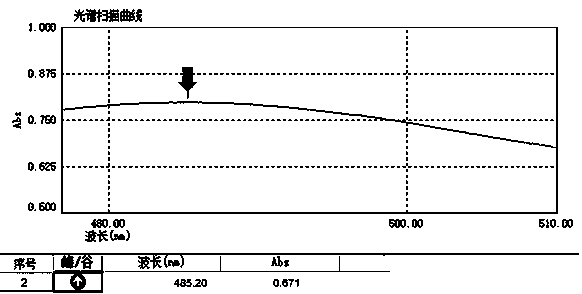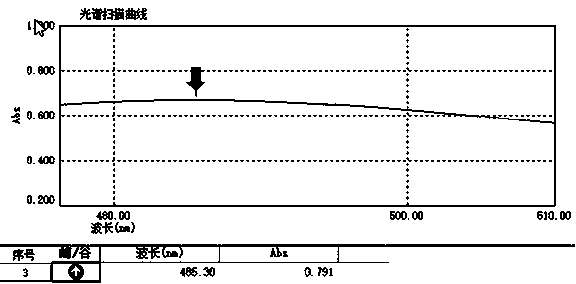Rapid detection method of plant root system activity
A plant root system and detection method technology, which is applied in the field of plant nutrition and physiology, can solve the problems of TTF loss, cumbersome operation, and long time consumption, and achieve the effects of shortening time, rapid extraction, and rapid detection
- Summary
- Abstract
- Description
- Claims
- Application Information
AI Technical Summary
Problems solved by technology
Method used
Image
Examples
Embodiment approach 1
[0024] Weigh 0.5 g of the wheat root sample that has been washed and dried on the surface, put it in a small beaker, add a TTC solution with a mass volume ratio of 0.4% and a phosphate buffer solution with a concentration of 1 / 15mol / L and a pH of 7.0 5ml each, so that the wheat root samples were fully immersed in the solution. After incubating in dark at 37°C for 1 hour, immediately add 2ml of sulfuric acid at a concentration of 1mol / L to terminate the reaction. At this time, the wheat root samples turned red. Then, transfer the wheat root sample that has turned red into a graduated test tube filled with 10ml of ethyl acetate and methanol mixed extract with a volume ratio of 1:1, and then place the above graduated test tube in a 60°C water bath , after leaching for 20min, the wheat root sample turned white, and the extract turned red, and then distilled to 10ml with ethyl acetate-methanol mixed extract. Finally, using a blank experiment as a control, use a spectrophotometer to...
Embodiment approach 2
[0027] Weigh 0.5 g of the corn root sample that has been cleaned and blotted dry on the surface, put it in a small beaker, add a TTC solution with a mass volume ratio of 0.4% and a phosphate buffer solution with a concentration of 1 / 15mol / L and a pH of 7.0 5ml each, so that the corn root sample was fully immersed in the solution, and after dark incubation at 37°C for 1h, immediately added 2ml of sulfuric acid with a concentration of 1mol / L to terminate the reaction, and the corn root sample turned red at this time. Then, transfer the corn root sample that has turned red into a graduated test tube filled with 10ml of ethyl acetate and methanol mixed extract with a volume ratio of 2:1, and then place the above graduated test tube in a 60°C water bath , after leaching for 25 minutes, the corn root sample turned white, and the extract turned red, and then distilled to 10ml with ethyl acetate-methanol mixed extract. Finally, using a blank experiment as a control, use a spectrophoto...
Embodiment approach 3
[0030]Weigh 0.5 g of the cucumber root sample that has been washed and blotted dry on the surface, put it in a small beaker, add a TTC solution with a concentration of 0.4% by mass volume ratio and a phosphate buffer with a concentration of 1 / 15mol / L and a pH of 7.0 5ml of each solution, so that the cucumber root samples were fully immersed in the solution, and after dark incubation at 37°C for 1 hour, immediately added 2ml of sulfuric acid with a concentration of 1mol / L to terminate the reaction, and the cucumber root samples turned red at this time. Then, transfer the cucumber root sample that has turned red into a graduated test tube filled with 10ml of ethyl acetate and methanol mixed extract with a volume ratio of 3:1, and then place the above graduated test tube in a 60°C water bath , after leaching for 15 minutes, the cucumber root sample turned white, and the extract turned red, and then dilute to 10ml with ethyl acetate-methanol mixed extract. Finally, using a blank e...
PUM
 Login to View More
Login to View More Abstract
Description
Claims
Application Information
 Login to View More
Login to View More - R&D
- Intellectual Property
- Life Sciences
- Materials
- Tech Scout
- Unparalleled Data Quality
- Higher Quality Content
- 60% Fewer Hallucinations
Browse by: Latest US Patents, China's latest patents, Technical Efficacy Thesaurus, Application Domain, Technology Topic, Popular Technical Reports.
© 2025 PatSnap. All rights reserved.Legal|Privacy policy|Modern Slavery Act Transparency Statement|Sitemap|About US| Contact US: help@patsnap.com



